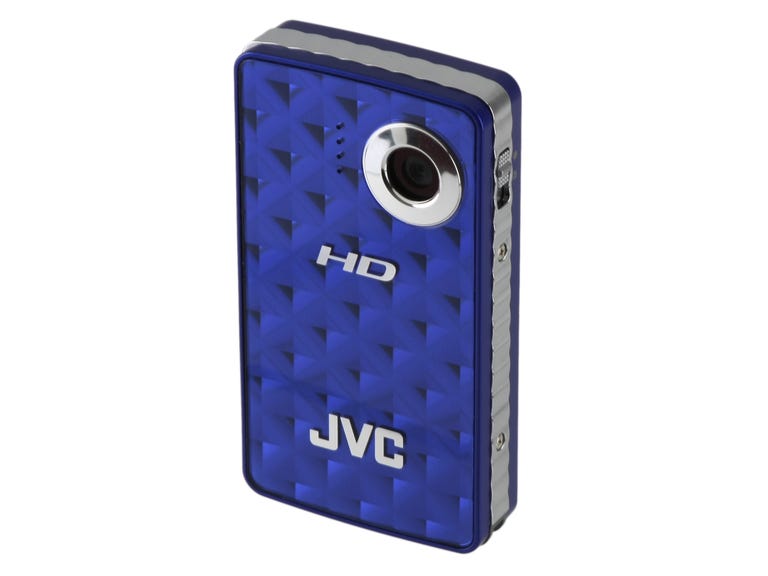The Good
The Bad
The Bottom Line
When jumping into a crowded market, especially one with a couple of strong players in the lead, a company has to work hard to distinguish its entries from the field. JVC successfully manages that with its debut product, the Picsio GC-FM1--unfortunately, not often in a good way.
On sight, you'd certainly never confuse this mini camcorder with comparably priced competitors like the sleek, first-generation Flip MinoHD or the bulky but top-notch Kodak Zi8. Though it comes in three attractive colors--deep purple, royal blue, and black--and an almost perfect size (a bit thicker than but otherwise smaller and about as light as a BlackBerry Pearl), its shiny faceted plastic face and wavy chrome-colored accent strip are about as sparkly as you can get without actually going the Swarovski-encrusted route. And while testing it in the park, I thought I had developed some magic squirrel-whispering powers until I realized that it was the camcorder that they were climbing the fence to see. Adult humans were less impressed, based on my casual office survey.
The wavy silver sort of camouflages the exposed USB, miniHDMI, and composite video jacks on one side and the macro switch on the other. Unlike many competitors, the FM1 doesn't have a built-in USB connector, though it includes a cable; nor does it bundle an HDMI cable like the Zi8. On the bottom is a tripod socket, hand strap connector, and a door covering the SD card slot and built-in battery.
The back--the side with the 2-inch LCD screen and buttons-- is quite attractively designed, but the controls are horribly annoying; they're too flat with no travel or feedback. You have to press the tiny power button with your nail, and there's always a pause before it registers so you're not sure if you have to press it again. With the four-way switch you control the digital zoom (never use it) as well as cycle through the different resolutions. The latter is incredibly frustrating. You press, hard because you don't feel anything, and nothing happens. Press and nothing happens. Press and nothing--wait, did that setting just change? At least there's no menu system to navigate with that control.
The other buttons--record/select, still/video toggle, playback, delete, and thumbnail view--feel responsive. The LCD is typical for this class, but hard to view in direct sunlight.
Plus, it feels like JVC bundled the cheapest software possible with the FM1: Pixela MediaBrowser LE. With it, you can browse and preview your clips and stills, download them, trim them, and upload them to iTunes or YouTube. You can't make brightness, contrast, or volume adjustments. It makes Flip Video's FlipShare--with its ability to import non-Flip file formats, like WMA and AVI; compile multiple clips into movies; and upload to sites like MySpace and Facebook as well as YouTube--seem like Final Cut Pro in comparison. And even to do a couple of those utterly basic tasks I had to reference the documentation. For instance, to copy videos from the camcorder to the computer using the software, you drag them from the list or calendar view to the words "Show All" in the Library Pane--hardly intuitive. Uploading to YouTube is easy and Wizard-driven enough, though. The software only runs on Windows, but as with all of these products you can drag and drop the files onto your Mac's hard disk and edit with iMovie.
The FM1 records QuickTime MOV files using H.264 compression and MPEG-4 encoding that delivers a highest-quality bit rate of about 12Mbps. Its highest resolution video is 1,440x1,080 pixels at 30fps, a size that was in vogue briefly before software and hardware was able to support real 1,920x1,080 1080p. The problem with it in this context is that most players and editing software will scale it up to 1,920x1,080, which degrades the quality. And it's odd, because the sensor, an 8-megapixel CMOS, is certainly large enough to support full HD. Other modes include 720p, VGA, and QVGA.
That said, the video quality isn't bad, relatively sharp and saturated with decent exposure. It seems to clip highlights worse than most, though, and the outdoor white balance is exceptionally cool. Under indoor lighting the quality is reasonable. It's not very noisy, but noise suppression makes the video look soft and smearier than most. It seems like the electronic image stabilizer helps a bit, but it's never rock solid. The audio is pretty loud, but tinny (as with all these camcorders). Still photos have excessively boosted contrast and saturation, which exacerbates the appearance of color noise; the camcorder really could have benefited from a lower-resolution sensor with better noise characteristics. Still, the photos look better than your typical camera phone.
Despite pretty good video and some nice features, including image stabilization and a macro focus mode, the JVC GC-FM1's impractical design and uncompetitive software offering make it hard to recommend over almost any of the current crop.



